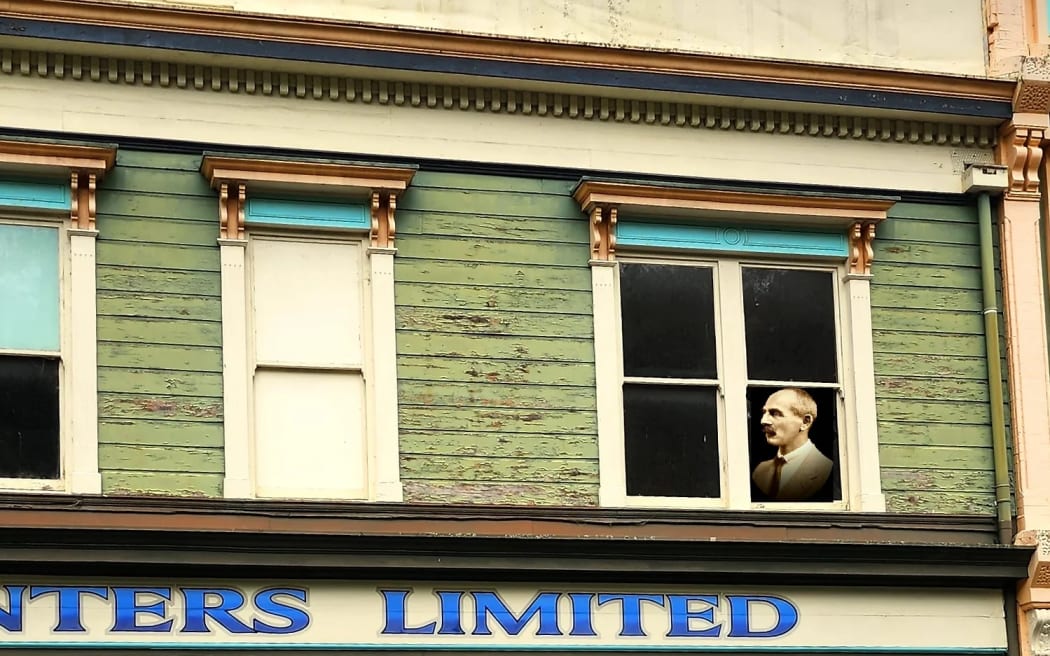
Photo: James Barron
The site where Whanganui's former mayor shot a returned soldier who was threatening to expose him as homosexual is New Zealand's first rainbow listing of a significant building
The site - 23 Ridgway Street in Whanganui - was the private office of the city's former mayor - Charles Mackay.
In 1920, Mackay shot returned soldier Walter D'Arcy Cresswell through the chest because Cresswell was threatening to out Mackay as homosexual, if he did not resign as mayor immediately.
Former district councillor and Whanganui businessman James Barron was behind the campaign to get the building recognised.
He told Sunday Morning the scandalous event saw Mackay go from meeting the Prince of Wales to fetching up in Mt Eden Prison within the space of a month.
The royal visit to Whanganui on 3 May, 1920, was significant and should have been a great event in the city's history, but it did not go very well, Barron said.
"The RSA and Mackay did not see eye-to-eye whatsoever, [the] RSA ran a competing reception for the prince actually."
Shortly thereafter - around 10 May - Cresswell arrived in Whanganui from the South Island and immediately made Mackay's acquaintance.
The two went to dinner on more than one occasion the following week and Mackay also gave Cresswell a private tour of the city's newly-opened Sarjeant Gallery, which was just one of many innovative projects Mackay had overseen as mayor.
Following the gallery tour, the pair went back to Mackay's law office at 23 Ridgway Street where, "the trap is sprung, essentially", Barron said.
"Mackay obviously makes advances to Cresswell, at least, and Cresswell then is offended, or feigns offence - although in [a] court statement he said he expected Mackay to do that, which is interesting - and immediately demands Mackay resign, which is a strange demand for a young man from the South Island to make."
Barron said the two met twice more in subsequent days to "negotiate" but at their meeting on 15 May, 1920: "Mackay snaps, grabs a revolver and shoots Cresswell, who recovers, throws a chair through the window, [and] yells 'murder, murder' out the window."
Six bullets were fired in the altercation, but it took Cresswell throwing the chair to alert the attention of the people on the street, Barron said.
"I find that fascinating."
Cresswell survived the shooting and Mackay was arrested for attempted murder and sentenced within a week.
Barron said that during Mackay's trial, part of his defence was that, around 1914, he had undergone hypnotherapy for his homosexuality.
"So [he was the] first recorded victim, I guess, of gay conversion therapy, which we only banned last year."
By 3 June 1920, Mackay was in Mt Eden Prison.
"So he's gone from meeting the Prince of Wales, [which] should've been the highlight of his career ... to being in jail within the period of one month," Barron said.
"It's quite a downfall, which is not coincidentally the title of the book written about him last year."
Barron said Mackay was jailed for around 15 years but was released after about eight, on the condition he leave the country, which he did - moving first to London and then to Berlin.
Cresswell also later left New Zealand and died in London in 1960.
Barron said it had been about an eight-month campaign to have the building recognised on Heritage New Zealand's Rainbow Project list.
Other buildings on the list include Frank Sargeson's Takapuna residence, and a 19th Century Cuba St building in Wellington connected to Carmen Rupe, the trailblazing transgender woman and entertainer.

